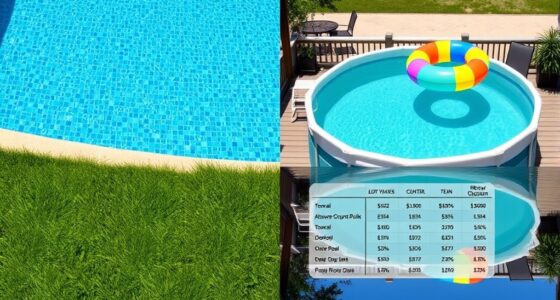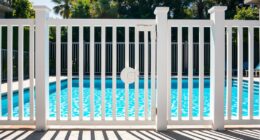When comparing a lap pool to a full-size pool, you’ll find that lap pools usually cost less upfront because they’re smaller and easier to install, requiring fewer materials and less labor. They also save you money on ongoing maintenance, energy, and chemicals. Conversely, full-size pools come with higher initial costs and higher long-term expenses for cleaning, safety measures, and energy use. To discover more about how these costs can affect your decision, keep exploring the details below.
Key Takeaways
- Lap pools generally have lower initial installation costs due to their smaller size and simpler design.
- Maintenance expenses for lap pools are typically lower because of reduced water volume and energy needs.
- Full-size pools incur higher ongoing costs from increased chemical, heating, and cleaning requirements.
- Safety features and measures tend to be more expensive for larger pools, raising overall expenses.
- Long-term operational costs, including energy, chemicals, and repairs, are usually higher for full-size pools.

When choosing between a lap pool and a full-size pool, understanding their differences can help you decide which best suits your needs. One of the key factors to consider is cost, which includes not only the initial investment but also ongoing expenses like pool maintenance and safety considerations. Lap pools are generally smaller and more streamlined, making them less expensive to install. Because they are narrower, they require fewer materials and less labor, which considerably reduces upfront costs. Full-size pools, on the other hand, take up more space and demand more construction work, increasing both material and labor expenses. This difference in size directly impacts the overall cost, with full-size pools often costing several times more than a lap pool.
Beyond the initial setup, the ongoing costs related to pool maintenance also differ. Smaller lap pools are simpler to maintain because they have less water volume, which means fewer chemicals are needed to keep the water clean and balanced. They also tend to require less energy for filtering and heating, leading to lower utility bills. Full-size pools demand more frequent maintenance, including more extensive cleaning, higher chemical use, and increased energy consumption for pumps and heaters. These ongoing costs can add up quickly over the years, making a lap pool a more economical option for those mindful of budget. Additionally, advanced filtration systems can further improve water quality and reduce maintenance effort, especially in larger pools.
Safety considerations are another vital element influencing the total cost. Larger pools pose increased safety risks, especially if they are not properly secured or if safety equipment isn’t in place. Installing safety features like fences, alarms, and covers can add to the total cost of a full-size pool. Conversely, lap pools, being smaller and often integrated into existing outdoor spaces, may require fewer safety modifications, which can reduce the overall investment. However, regardless of size, proper safety measures are essential to prevent accidents, especially if children or pets have access to the area.
When weighing the costs, you should also think about long-term expenses. Larger pools tend to have higher insurance premiums, more frequent repairs, and greater energy and chemical costs over time. Smaller lap pools, due to their size and simpler maintenance needs, typically incur lower ongoing expenses. Overall, the cost differences between a lap pool and a full-size pool extend beyond the initial price tag, encompassing maintenance, safety features, and operational costs. Your decision should factor in both your budget and your safety priorities, ensuring you choose a pool that fits your lifestyle and financial plan while keeping safety at the forefront.
Frequently Asked Questions
Which Pool Type Requires More Maintenance Over Time?
You’ll find that a full-size pool requires more maintenance over time because it has a larger surface area, leading to higher water treatment costs and more frequent cleaning. Pool cover costs are also higher for larger pools, as they need sturdier covers. With a lap pool, maintenance is generally lower due to its smaller size, which means less water treatment and easier upkeep. Overall, larger pools demand more ongoing effort and expenses.
Are There Space Limitations for Installing a Lap Pool?
You might encounter space constraints when installing a lap pool, especially if your yard is small. Limited space can pose installation challenges, requiring careful planning to fit the pool comfortably without overcrowding. It’s important to measure your area accurately and consider any surrounding structures or landscaping. If space is tight, a custom or compact lap pool could be a smart solution, ensuring you get the benefits without compromising your yard’s layout.
How Does Pool Size Affect Energy Consumption?
Imagine your pool as a heart, pulsing with energy every time you swim. A larger pool demands more energy to maintain warmth and filtration, making it less energy-efficient. To counter this, you can enhance pool insulation, helping keep the water warm with less effort. Smaller pools generally consume less energy, but proper insulation guarantees your energy use stays manageable, whether your pool is a tranquil lap lane or a sprawling oasis.
Can a Lap Pool Be Used for Casual Swimming?
A lap pool can definitely be used for casual swimming, though its primary utility is for fitness and training. Its narrow design limits space for relaxed, leisurely swims, but if you’re comfortable with a smaller area, you’ll find casual swimming feasible. Keep in mind, the lap pool’s utility focuses on exercise, so it may lack the room and features that make casual swimming more enjoyable in a full-size pool.
What Are Safety Considerations Unique to Full-Size Pools?
Think of a full-size pool as a bustling ocean—exciting but filled with risks. You need to guarantee safety by installing sturdy pool fencing to keep kids and pets out of danger. Watch out for slip hazards around the deck, especially when wet. Regularly check for loose tiles or uneven surfaces. These precautions help prevent accidents and make your pool a safe haven for everyone.
Conclusion
Choosing between a lap pool and a full-size pool isn’t just about space or style—it’s about your priorities. A lap pool offers affordability and efficiency, perfect for focused workouts and limited yards. Meanwhile, a full-size pool turns your backyard into a private oasis, ideal for relaxing and entertaining. Think about what matters most to you: streamlined fitness or versatile leisure. Your ideal pool balances cost and enjoyment, making every splash worth it.









